
Our research
The Dynamics and Vibration group carries out world-leading research with strong industry links in the following areas:
Earthquake engineering and structural vibration
Earthquake engineering
Earthquake resistant design for buildings is not required in the UK. However, larger earthquakes have to be considered for the development of UK nuclear power plants (NNPs).
Our group has developed a stochastic ground motion accelerogram model for north-west Europe – the first of its kind for the region. Thus we can assess the seismic risk to NPPs in the UK, based on the defined ground input.
This approach uses direct stochastic simulation of seismic input to conduct nonlinear dynamic analysis of structure models of NPPs. Therefore it does not require the use ground motion prediction equations (GMPE) and the scalling/matching procedures in conventional procedures. In addition, we have also studied the risk control of NPPs using seismic protection systems in stable continental regions.
Structural vibration
Structural vibration induced by human movements is a major design concern as structures become more slender and lighter. We have contributed to several design guides on human-induced structural vibration.
We have originated and continued both experimental and theoretical research on human-structure interaction where stationary people are involved, proposed the human whole-body models in structural vibration and determined the dynamic properties of the standing subjects. This research predicts human whole-body vibration and the links between structural vibration, human-body vibration and human comfort.
We have consulted on challenging engineering vibration problems for structures such as the London Eye, Wembley and Ibrox stadia.
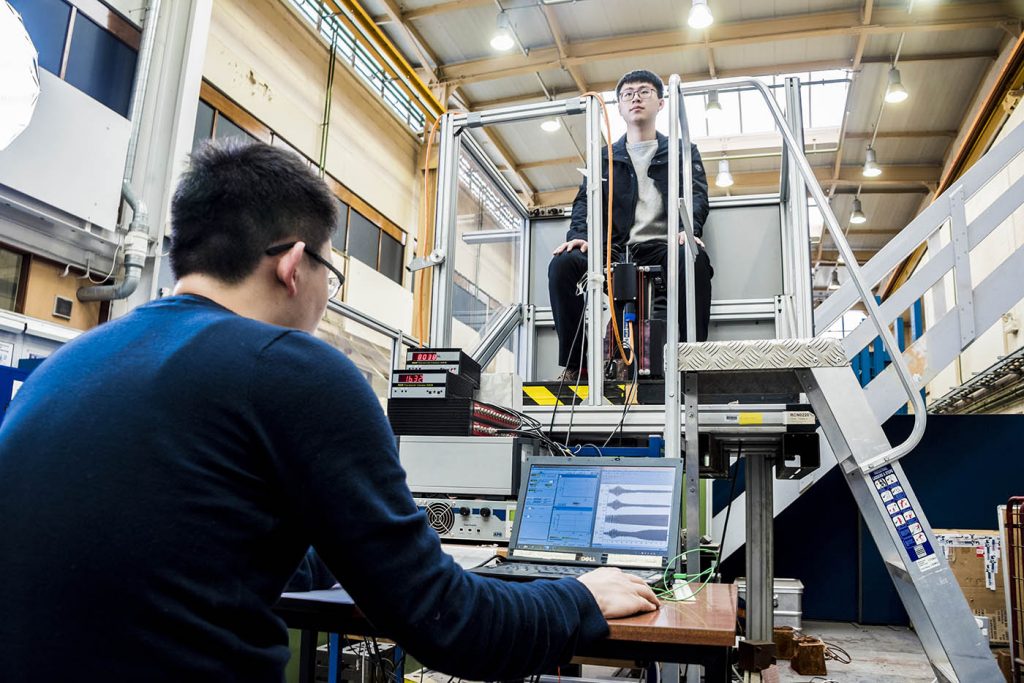
Human-structure interaction rig for crowd loading dynamic analysis
Rotating machinery - bearings and vibration
Oil-free turbomachinery technology
Oil-free turbomachinery is an emerging green technology that typically uses foil-air bearings. The elimination of oil lubrication brings environmental and technological benefits, particularly for high-speed applications, where rolling-element bearings are operating at their specification limits.
Manchester has pioneered UK university research in this field through EP/I029184/1, which was the first to devise a suite of algorithms for the simultaneous solution of the differential equations governing the coupled nonlinear dynamics of the rotor, air film and foil structure domains.
Manchester research in FABs is currently expanding from its original dynamics aspect to include manufacturing and materials technologies. Collaboration is currently under way with Dyson.
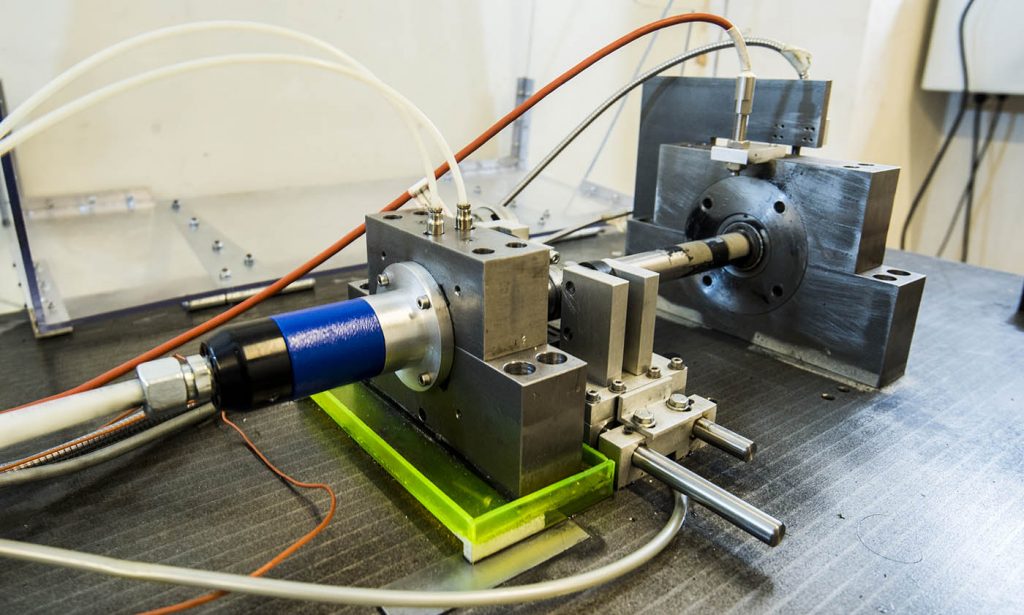
High-speed rotor test rig for foil-air bearings – used in oil-free turbomachinery
Measurement Systems (Blade Tip Timing)
Blade tip timing (BTT) is a non-contact measurement system for measuring the vibration of turbomachinery blades, thus enabling the determination of their fatigue limits.
BTT is currently replacing strain gauge systems due its technological and cost saving benefits, particularly since it eliminates the need for expensive slip rings or telemetry systems, and is the only viable solution for harsh operating conditions. For the past two decades, Manchester has been at the forefront of this research through a series of collaborative projects with industry, including Samulet Project 1 – High efficiency turbomachinery (EPSRC EP/H00128X/1). Other collaborators in this field have included Rolls-Royce, Rotadata, and EMTD.
Non-linear dynamics and tribology
This area concerns the analysis (theoretical and experimental) of the non-linear dynamics of rotating machinery, which is essential for guaranteeing its structural integrity. It also covers expertise in tribology of non-linear bearings (eg aero engine squeeze-film bearings, floating ring bearings used on turbochargers, foil-air bearings etc).
Advanced algorithms have been developed for the solution of both the forward problem (simulation of vibration response) and the inverse problem (identification of rotational unbalance from measured casing vibration).
These solvers can be efficiently used on whole machine/engine models with nonlinear bearings and work in either the time domain (via implicit numerical integration) or the frequency domain (multi-frequency harmonic balance). Bearings are modelled either physically or through system identification techniques.
Past work in this area has been supported by EPSRC and industry (e.g. EP/D054575/1).
Structural and machinery health monitoring
Structural and machinery health monitoring
The area of structural health monitoring (SHM) has grown in importance over the last two decades for the management of ageing structures. For example, many bridges in the UK have exceeded their design life but are still being used.
The use of SHM techniques to monitor the structural integrity of such structures has become very important in order to prevent sudden catastrophic failures. Structural damage detection techniques based on vibration and wave propagation techniques have been developed.
These techniques can identify and locate structural faults and determine its severity. They have been extended to delamination detection and localisation in composite laminate beams and plates and to machinery health monitoring. Below, the figure illustrates vibration-based crack/damage detection in a simply-supported beam which represents a bridge deck.
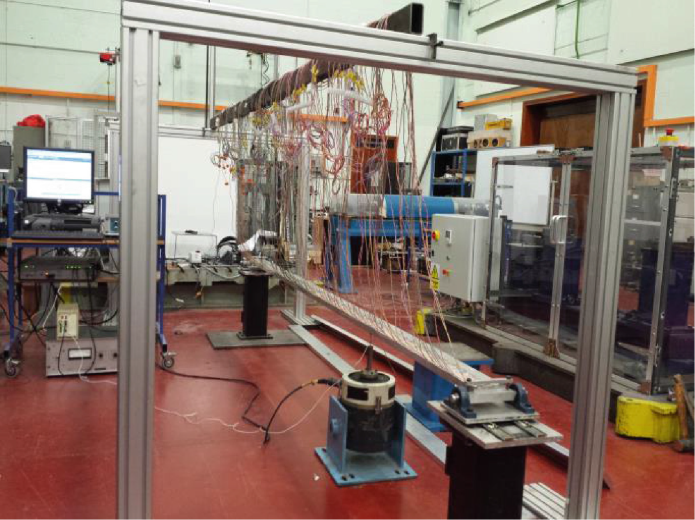
Blockage and leakage detection in pipelines
Blockage and leakage in urban water distribution pipe networks, oil and gas pipelines, and sewage pipelines have potentially serious economic, health, safety and environmental consequences.
We have developed acoustic wave propagation and reflectometry techniques to remotely identify and locate blockages and leaks in pipe networks.
The techniques can also assess the degree of severity of the blockage or leakage. Investigations have involved finite element analysis, computational fluid dynamics analysis and experimental validation.
Vibration control using smart materials/structures
Passive vibration control using viscoelastic materials
Passive vibration isolation and control using viscoelastic materials is a strong area of our group’s expertise. This research – including complex analyses of the material properties of rubbers, elastomers and polymers – has been applied to a wide range of engineering vibration and shock isolation problems from the automotive, marine, aerospace and building industries. Our work has been supported by several UK and international companies, the EPSRC and Innovate UK.
Active/Semi-active vibration control using smart materials/structures
Broadly, this area involves the development and applications of smart materials and structures for active and semi-active vibration/shock control.
Specifically, this includes investigation of novel applications of piezoceramic/piezoelectric materials for active vibration control and of shape memory alloy (SMA) wires for morphing aircraft wing design.
This also includes the characterisation and applications of electrorheological and magnetorheological fluids for actuator and damper design and for semi-active vibration/shock absorption and control.
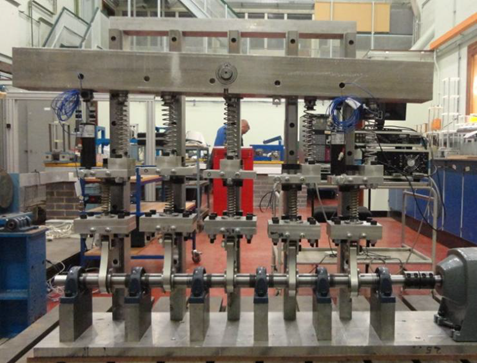
Half model of a tracked vehicle with smart-fluid dampers.
Vibration energy harvesting and wireless sensing
Wireless sensing with power management middleware
The continuous remote monitoring of complex engineering assets, such as refineries and petrochemical plants, and of assets located in extreme environments, such as off-shore structures, using wireless sensors is becoming very important.
Our group has represented the University of Manchester as a partner in the EU DYNAMITE Integrated Project on Dynamic Decisions in Maintenance. The role of the group was to develop low-cost smart sensors for measuring temperature, pressure, and vibration with wireless sensing capability using the Imote2 sensor node.
It also involved the developments of energy harvesting devices using solar and vibration energy harvesting devices, a middleware power management electronic system and data structure using the MIMOSA protocol.
Vibration energy harvesting
We have developed piezoelectric vibration energy harvesting progressively as a research area over the past decade. The aim is to harvest energy from ambient sources for micro-power generation for wireless sensor networks (WSNs) and portable electronics (mobile phones, laptops, MP3s, etc).
The EU DYNAMITE Integrated Project described above has progressed into the development of wideband, multi-frequency energy harvesting devices using piezoelectric patches as illustrated by the figure below.
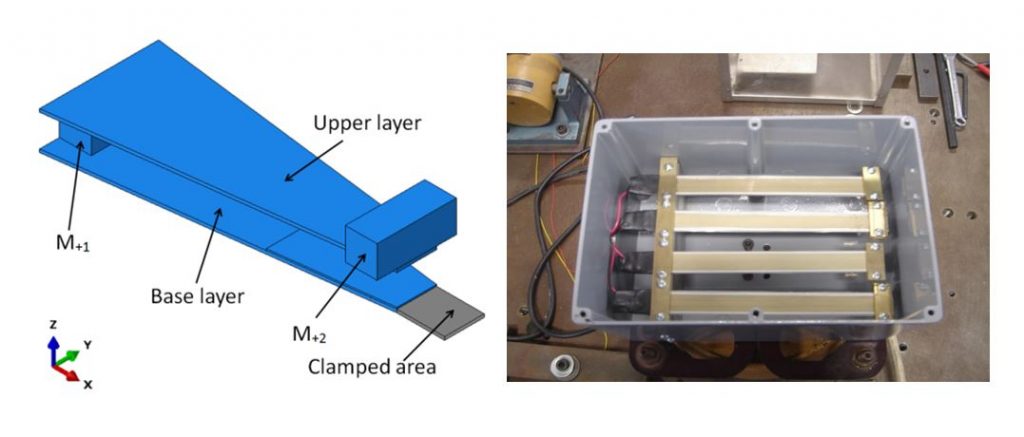
(Left) Model of a tapered piezoelectric vibration energy harvester; (right) multiple piezo fibre composite (PFC) vibration energy harvester
Opportunities
Find out about research opportunities in engineering dynamics and how to apply.
Facilities
Explore our experimental facilities for Dynamics, Vibration and Earthquake engineering.

